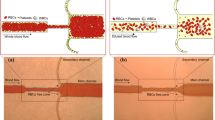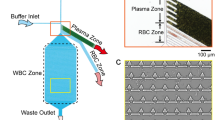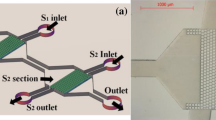Abstract
One of the major areas of active research in microfluidics is in biological applications. These applications often require complex analysis of biological fluids for clinical diagnostics. One such complex multicomponent suspension is blood, a mixture of cells suspended in plasma. The cellular components constitute RBCs, WBCs, and platelets. Platelets play a fundamental role in blood clotting mechanism and their efficient functioning is of utmost importance. Platelet separation is necessary for disease diagnostics, transfusion, and research purposes. Centrifugation is commonly employed for platelet separation. However, researchers are developing techniques to enable platelet separation using microfluidics as a tool, primarily due to the various advantages offered while working at microscale. In this review, we investigate and highlight various microscale platelet separation techniques currently available, focusing on their design, working principle, and performance aspects. The issues, challenges, and further possibilities of research and development are also underscored. Our review indicates that not many microdevices for platelet separation are currently available, pointing to an important void that needs to be urgently filled. A brief discussion on the conventional method of platelet separation and platelet dynamics is also included.




Adapted from Ref.45 by permission from The Royal Society of Chemistry.

Adapted from Ref.21 by permission from The Royal Society of Chemistry.

Adapted from Ref.58 by permission from American Chemical Society.

Similar content being viewed by others
References
Janasek D, Franzke J, Manz A (2006) Scaling and the design of miniaturized chemical-analysis systems. Nature 442(7101):374–380
Sackmann EK, Fulton AL, Beebe DJ (2014) The present and future role of microfluidics in biomedical research. Nature 507(7491):181–189
Whitesides GM (2006) The origins and the future of microfluidics. Nature 442(7101):368–373
Chakraborty S (ed) (2012) Microfluidics and microscale transport processes. CRC Press, Boca Raton
Panigrahi PK (2016) Transport phenomena in microfluidic systems. John Wiley, Hoboken
Stone HA, Stroock AD, Ajdari A (2004) Engineering flows in small devices: microfluidics toward a lab-on-a-chip. Annu Rev Fluid Mech 36:381–411
Fung YC (1981) Biomechanics: mechanical properties of living tissues. Springer, New York
Caro CG (2011) The mechanics of the circulation. Cambridge University Press, Cambridge
Toner M, Irimia D (2005) Blood-on-a-chip. Annu Rev Biomed Eng 7:77–103
Hou HW, Bhagat AAS, Lee WC, Huang S, Han J, Lim CT (2011) Microfluidic devices for blood fractionation. Micromachines 2(3):319–343
Yu ZTF, Aw Yong KM, Fu J (2014) Microfluidic blood cell sorting: now and beyond. Small 10(9):1687–1703
Shields CW IV, Reyes CD, Lopez GP (2015) Microfluidic cell sorting: a review of the advances in the separation of cells from debulking to rare cell isolation. Lab Chip 15(5):1230–1249
Gossett DR, Weaver WM, Mach AJ, Hur SC, Tse HTK, Lee W, Di Carlo D (2010) Label-free cell separation and sorting in microfluidic systems. Anal Bioanal Chem 397(8):3249–3267
Kersaudy-Kerhoas M, Sollier E (2013) Micro-scale blood plasma separation: from acoustophoresis to egg-beaters. Lab Chip 13(17):3323–3346
Lima R, Ishikawa T, Imai Y, Yamaguchi T (2012) Blood flow behavior in microchannels: past, current and future trends. In: Dias R, Lima R, Martins AA, Mata TM (eds) Single and two phase flows on chemical and biomedical engineering. Bentham Science, United States of America, pp 513–547
Tripathi S, Kumar YBV, Prabhakar A, Joshi SS, Agrawal A (2015) Passive blood plasma separation at the microscale: a review of design principles and microdevices. J Micromech Microeng 25(8):083001
Liesner RJ, Machin SJ (1997) ABC of clinical haematology: platelet disorders. BMJ 314(7083):809
Harmening DM (1997) Clinical hematology and fundamentals of hemostasis. F. A. Davis Company, Philadelphia
Rodak BF, Carr JH (2015) Clinical hematology, Atlas-E-Book. Elsevier, New York City
Hou Y, Carrim N, Wang Y, Gallant RC, Marshall A, Ni H (2015) Platelets in hemostasis and thrombosis: novel mechanisms of fibrinogen-independent platelet aggregation and fibronectin-mediated protein wave of hemostasis. Biomed Res 29(6):437
Choi S, Ku T, Song S, Choi C, Park JK (2011) Hydrophoretic high-throughput selection of platelets in physiological shear-stress range. Lab Chip 11(3):413–418
Yazdani A, Karniadakis GE (2016) Sub-cellular modeling of platelet transport in blood flow through microchannels with constriction. Soft Matter 12(19):4339–4351
Gale AJ (2011) Continuing education course# 2: current understanding of hemostasis. Toxicol Pathol 39(1):273–280
Boon GD (1993) An overview of hemostasis. Toxicol Pathol 21(2):170–179
Santos-Martínez MJ, Prina-Mello A, Medina C, Radomski MW (2011) Analysis of platelet function: role of microfluidics and nanodevices. Analyst 136(24):5120–5126
Leslie M (2010) Beyond clotting: the powers of platelets. Science 328:562–564
von Hundelshausen P, Weber C (2007) Platelets as immune cells: bridging inflammation and cardiovascular disease. Circ Res 100(1):27–40
Huebsch LB, Harker LA (1981) Disorders of platelet function: mechanisms, diagnosis and management. West J Med 134(2):109
Dhurat R, Sukesh MS (2016) Principles and methods of preparation of platelet-rich plasma: a review and author’s perspective. J Cutan Aesthet Surg 7:189–197
Marx RE (2001) Platelet-rich plasma (PRP): what is PRP and what is not PRP? Implant Dent 10(4):225–228
Lana JFSD, Santana MHA, Belangero WD, Luzo ACM (eds) (2013) Platelet-rich plasma: regenerative medicine: sports medicine, orthopedic, and recovery of musculoskeletal injuries. Springer, Berlin
Smith RG, Gassmann CJ, Campbell MS (2007) Platelet-rich plasma: properties and clinical applications. J Lanc Gen Hosp 2(2):73–77
Maffulli N (ed) (2016) Platelet rich plasma in musculoskeletal practice. Springer, London
Tripathi S, Kumar YBV, Agrawal A, Prabhakar A, Joshi SS (2016) Microdevice for plasma separation from whole human blood using bio-physical and geometrical effects. Sci Rep 6:26749
Savage B, Ruggeri ZM (2007) Platelet thrombus formation in flowing blood. In: Michelson AD (ed) Platelets, 2nd edn. Elsevier/Academic Press, San Diego, pp 359–367
Pamme N (2007) Continuous flow separations in microfluidic devices. Lab Chip 7(12):1644–1659
Gulliksson H (2012) Platelets from platelet-rich-plasma versus buffy-coat-derived platelets: what is the difference? Rev Bras Hematol Hemoter 34(2):76
Hoareau GL, Jandrey KE, Burges J, Bremer D, Tablin F (2014) Comparison of the platelet-rich plasma and buffy coat protocols for preparation of canine platelet concentrates. Vet Clin Pathol 43(4):513–518
Sabarish R, Lavu V, Rao SR (2015) A comparison of platelet count and enrichment percentages in the platelet rich plasma (prp) obtained following preparation by three different methods. J Clin Diagn Res 9(2):ZC10–ZC12
Fitzpatrick J, Bulsara MK, McCrory PR, Richardson D, Zheng MH (2017) Analysis of platelet-rich plasma extraction-variations in platelet and blood components between 4 common commercial kits. Orthop J Sports Med 5:1–8
Marques FP, Ingham SJM, Forgas A, Franciozi CEDS, Sasaki PH, Abdalla RJ (2014) A manual method to obtain platelet rich plasma. Acta Ortop Bras 22(2):75–77
Pommer MS, Zhang Y, Keerthi N, Chen D, Thomson JA, Meinhart CD, Soh HT (2008) Dielectrophoretic separation of platelets from diluted whole blood in microfluidic channels. Electrophoresis 29(6):1213–1218
Piacentini N, Mernier G, Tornay R, Renaud P (2011) Separation of platelets from other blood cells in continuous-flow by dielectrophoresis field-flow-fractionation. Biomicrofluidics 5(3):034122
Nam J, Lim H, Kim D, Shin S (2011) Separation of platelets from whole blood using standing surface acoustic waves in a microchannel. Lab Chip 11(19):3361–3364
Chen Y, Wu M, Ren L, Liu J, Whitley PH, Wang L, Huang TJ (2016) High-throughput acoustic separation of platelets from whole blood. Lab Chip 16(18):3466–3472
Dykes J, Lenshof A, Astrand-Grundstrom B, Laurell T, Scheding S (2011) Efficient removal of platelets from peripheral blood progenitor cell products using a novel micro-chip based acoustophoretic platform. PLoS One 6(8):e23074
Yousuff CM, Ho ETW, Hussain KI, Hamid NHB (2017) Microfluidic platform for cell isolation and manipulation based on cell properties. Micromachines 8(1):15
Moen ST, Hatcher CL, Singh AK (2016) A centrifugal microfluidic platform that separates whole blood samples into multiple removable fractions due to several discrete but continuous density gradient sections. PLoS One 11(4):e0153137
Prabhakar A, Kumar YBV, Tripathi S, Agrawal A (2015) A novel, compact and efficient microchannel arrangement with multiple hydrodynamic effects for blood plasma separation. Microfluid Nanofluidics 18(5–6):995–1006
Di Carlo D, Edd JF, Irimia D, Tompkins RG, Toner M (2008) Equilibrium separation and filtration of particles using differential inertial focusing. Anal Chem 80(6):2204–2211
Choi S, Song S, Choi C, Park JK (2007) Continuous blood cell separation by hydrophoretic filtration. Lab Chip 7(11):1532–1538
Huang LR, Cox EC, Austin RH, Sturm JC (2004) Continuous particle separation through deterministic lateral displacement. Science 304(5673):987–990
McGrath J, Jimenez M, Bridle H (2014) Deterministic lateral displacement for particle separation: a review. Lab Chip 14(21):4139–4158
Li N, Kamei DT, Ho CM (2007) On-chip continuous blood cell subtype separation by deterministic lateral displacement. In: Nano/micro engineered and molecular systems, 2007. NEMS’07. 2nd IEEE International Conference, pp 932–936
Inglis DW, Morton KJ, Davis JA, Zieziulewicz TJ, Lawrence DA, Austin RH, Sturm JC (2008) Microfluidic device for label-free measurement of platelet activation. Lab Chip 8(6):925–931
Geislinger TM, Eggart B, Braunmüller S, Schmid L, Franke T (2012) Separation of blood cells using hydrodynamic lift. Appl Phys Lett 100(18):183701
Dickson MN, Amar L, Hill M, Schwartz J, Leonard EF (2012) A scalable, micropore, platelet rich plasma separation device. Biomed Microdevices 14(6):1095–1102
Basabe-Desmonts L, Ramstrom S, Meade G, O’neill S, Riaz A, Lee LP, Kenny D (2010) Single-step separation of platelets from whole blood coupled with digital quantification by interfacial platelet cytometry (iPC). Langmuir 26(18):14700–14706
Cokelet GR, Goldsmith HL (1991) Decreased hydrodynamic resistance in the two-phase flow of blood through small vertical tubes at low flow rates. Circ Res 68:1–17
Goldsmith HL, Cokelet GR, Gaehtgens P (1989) Robin Fahraeus: evolution of his concepts in cardiovascular physiology. Am J Physiol Heart Circ Physiol 257:H1005–H10015
Thurston GB (1988) Plasma release-cell layering theory for blood flow. Biorheology 26:199–214
Fedosov DA, Caswell BB, Popel AS, Karniadakis GE (2010) Blood flow and cell-free layer in microvessels. Microcirculation 17:615–628
Zhang J, Johnson PC, Popel AS (2009) Effects of erythrocyte deformability and aggregation on the cell free layer and apparent viscosity of microscopic blood flows. Microvasc Res 77:265–272
Fahraeus R (1929) The suspension stability of the blood. Physiol Rev 9:241–274
Barbee JH, Cokelet GH (1971) The Fahraeus effect. Microvasc Res 3:6–16
Fahraeus R, Lindqvist T (1931) The viscosity of the blood in narrow capillary tubes. Am J Physiol 96:562–568
Nicholson JW (2007) The chemistry of medical and dental materials. Royal Society of Chemistry, London
Wang W, Diacovo TG, Chen J, Freund JB, King MR (2013) Simulation of platelet, thrombus and erythrocyte hydrodynamic interactions in a 3D arteriole with in vivo comparison. PLoS One 8(10):e76949
Fogelson AL, Neeves KB (2015) Fluid mechanics of blood clot formation. Annu Rev Fluid Mech 47:377–403
Tangelder GJ, Slaaf DW, Muijtjens AM, Arts T, Oude Egbrink MG, Reneman RS (1986) Velocity profiles of blood platelets and red blood cells flowing in arterioles of the rabbit mesentery. Circ Res 59(5):505–514
Woldhuis B, Tangelder GJ, Slaaf DW, Reneman RS (1992) Concentration profile of blood platelets differs in arterioles and venules. Am J Physiol 262:H1217–H1223
Aarts PA, Van den Broek SA, Prins GW, Kuiken GD, Sixma JJ, Heethaar RM (1988) Blood platelets are concentrated near the wall and red blood cells, in the center in flowing blood. Arterioscler Thromb Vasc Biol 8(6):819–824
Tilles AW, Eckstein EC (1987) The near-wall excess of platelet-sized particles in blood flow: its dependence on hematocrit and wall shear rate. Microvasc Res 33(2):211–223
Eckstein EC, Tilles AW, Millero FJ III (1988) Conditions for the occurrence of large near-wall excesses of small particles during blood flow. Microvasc Res 36(1):31–39
Zhao R, Kameneva MV, Antaki JF (2007) Investigation of platelet margination phenomena at elevated shear stress. Biorheology 44(3):161–177
Tangelder GJ, Slaaf DW, Teirlinck HC, Alewijnse R, Reneman RS (1982) Localization within a thin optical section of fluorescent blood platelets flowing in a microvessel. Microvasc Res 23(2):214–230
Kruger T (2016) Effect of tube diameter and capillary number on platelet margination and near-wall dynamics. Rheol Acta 55(6):511–526
AlMomani T, Udaykumar HS, Marshall JS, Chandran KB (2008) Micro-scale dynamic simulation of erythrocyte–platelet interaction in blood flow. Ann Biomed Eng 36(6):905–920
Eckstein EC, Belgacem F (1991) Model of platelet transport in flowing blood with drift and diffusion terms. Biophys J 60(1):53–69
Turitto VT, Benis AM, Leonard EF (1972) Platelet diffusion in flowing blood. Ind Eng Chem Fundam 11(2):216–223
Crowl LM, Fogelson AL (2010) Computational model of whole blood exhibiting lateral platelet motion induced by red blood cells. Int J Numer Method Biomed Eng 26(3–4):471–487
Jordan A, David T, Homer-Vanniasinkam S, Graham A, Walker P (2004) The effects of margination and red cell augmented platelet diffusivity on platelet adhesion in complex flow. Biorheology 41(5):641–653
Goldsmith HL (1971) Red cell motions and wall interactions in tube flow. Fed Proc 30:1578–1588
Zhao H, Shaqfeh ES (2011) Shear-induced platelet margination in a microchannel. Phys Rev E 83(6):061924
Zhao H, Shaqfeh ES, Narsimhan V (2012) Shear-induced particle migration and margination in a cellular suspension. Phys Fluids 24(1):011902
Reasor DA, Mehrabadi M, Ku DN, Aidun CK (2013) Determination of critical parameters in platelet margination. Ann Biomed Eng 41(2):238–249
Segre G, Silberber A (1961) Radial particle displacements in Poiseuille flow of suspensions. Nature 189:209–210
Kumar A, Graham MD (2012) Margination and segregation in confined flows of blood and other multicomponent suspensions. Soft Matter 8(41):10536–10548
Zhao R, Marhefka JN, Shu F, Hund SJ, Kameneva MV, Antaki JF (2008) Micro-flow visualization of red blood cell-enhanced platelet concentration at sudden expansion. Ann Biomed Eng 36(7):1130
Rasche H (2001) Haemostasis and thrombosis: an overview. Eur Heart J 3(suppl_Q):Q3–Q7
Aarts PA, Heethaar RM, Sixma JJ (1984) Red blood cell deformability influences platelets-vessel wall interaction in flowing blood. Blood 64(6):1228–1233
Wu WT, Aubry N, Massoudi M, Antaki JF (2017) Transport of platelets induced by red blood cells based on mixture theory. Int J Eng Sci 118:16–27
Acknowledgements
This work is supported by the IMPRINT scheme of MHRD (Ministry of Human resource Development), Government of India.
Author information
Authors and Affiliations
Corresponding author
Rights and permissions
About this article
Cite this article
Laxmi, V., Tripathi, S., Joshi, S.S. et al. Microfluidic Techniques for Platelet Separation and Enrichment. J Indian Inst Sci 98, 185–200 (2018). https://doi.org/10.1007/s41745-018-0072-6
Received:
Accepted:
Published:
Issue Date:
DOI: https://doi.org/10.1007/s41745-018-0072-6




